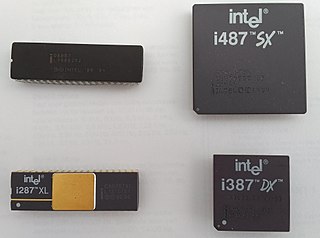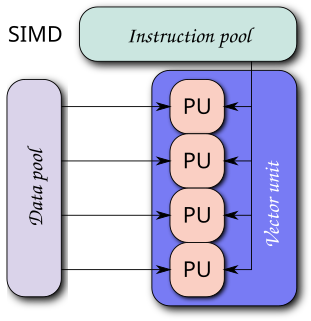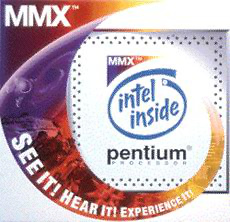
The Intel 80386, also known as i386 or just 386, is a 32-bit microprocessor introduced in 1985. The first versions had 275,000 transistors and were the CPU of many workstations and high-end personal computers of the time. As the original implementation of the 32-bit extension of the 80286 architecture, the 80386 instruction set, programming model, and binary encodings are still the common denominator for all 32-bit x86 processors, which is termed the i386-architecture, x86, or IA-32, depending on context.

The Motorola 68060 ("sixty-eight-oh-sixty") is a 32-bit microprocessor from Motorola released in 1994. It is the successor to the Motorola 68040 and is the highest performing member of the 68000 series. Two derivatives were produced, the 68LC060 and the 68EC060.

x86 is a family of instruction set architectures initially developed by Intel based on the Intel 8086 microprocessor and its 8088 variant. The 8086 was introduced in 1978 as a fully 16-bit extension of Intel's 8-bit 8080 microprocessor, with memory segmentation as a solution for addressing more memory than can be covered by a plain 16-bit address. The term "x86" came into being because the names of several successors to Intel's 8086 processor end in "86", including the 80186, 80286, 80386 and 80486 processors.
The NS32000, sometimes known as the 32k, is a series of microprocessors produced by National Semiconductor. The first member of the family, the 32016, came to market in 1982, making it the first 32-bit general-purpose microprocessor on the market. However, the 32016 contained a large number of bugs and often could not be run at its rated speed. These problems, and the presence of the similar Motorola 68000, led to almost no use in the market.

A floating-point unit is a part of a computer system specially designed to carry out operations on floating-point numbers. Typical operations are addition, subtraction, multiplication, division, and square root. Some FPUs can also perform various transcendental functions such as exponential or trigonometric calculations, but the accuracy can be very low, so that some systems prefer to compute these functions in software.

Single instruction, multiple data (SIMD) is a class of parallel computers in Flynn's taxonomy. It describes computers with multiple processing elements that perform the same operation on multiple data points simultaneously. Such machines exploit data level parallelism, but not concurrency: there are simultaneous (parallel) computations, but only a single process (instruction) at a given moment. SIMD is particularly applicable to common tasks such as adjusting the contrast in a digital image or adjusting the volume of digital audio. Most modern CPU designs include SIMD instructions to improve the performance of multimedia use. SIMD is not to be confused with SIMT, which utilizes threads.

MMX is a single instruction, multiple data (SIMD) instruction set designed by Intel, introduced in January 1997 with its P5-based Pentium line of microprocessors, designated as "Pentium with MMX Technology". It developed out of a similar unit introduced on the Intel i860, and earlier the Intel i750 video pixel processor. MMX is a processor supplementary capability that is supported on recent IA-32 processors by Intel and other vendors.
In computing, Streaming SIMD Extensions (SSE) is a single instruction, multiple data (SIMD) instruction set extension to the x86 architecture, designed by Intel and introduced in 1999 in their Pentium III series of Central processing units (CPUs) shortly after the appearance of Advanced Micro Devices (AMD's) 3DNow!. SSE contains 70 new instructions, most of which work on single precision floating point data. SIMD instructions can greatly increase performance when exactly the same operations are to be performed on multiple data objects. Typical applications are digital signal processing and graphics processing.
The Motorola 68000 series is a family of 32-bit CISC microprocessors. During the 1980s and early 1990s, they were popular in personal computers and workstations and were the primary competitors of Intel's x86 microprocessors. They were most well known as the processors powering the early Apple Macintosh, the Sharp X68000, the Commodore Amiga, the Sinclair QL, the Atari ST, the SNK NG AES/Neo Geo CD, the Sega Genesis, Atari Jaguar and Commodore CDTV. Although no modern desktop computers are based on processors in the 68000 series, derivative processors are still widely used in embedded systems.
SSE2 is one of the Intel SIMD processor supplementary instruction sets first introduced by Intel with the initial version of the Pentium 4 in 2000. It extends the earlier SSE instruction set, and is intended to fully replace MMX. Intel extended SSE2 to create SSE3 in 2004. SSE2 added 144 new instructions to SSE, which has 70 instructions. Competing chip-maker AMD added support for SSE2 with the introduction of their Opteron and Athlon 64 ranges of AMD64 64-bit CPUs in 2003.

Intel's i960 was a RISC-based microprocessor design that became popular during the early 1990s as an embedded microcontroller. It became a best-selling CPU in that segment, along with the competing AMD 29000. In spite of its success, Intel stopped marketing the i960 in the late 1990s, as a result of a settlement with DEC whereby Intel received the rights to produce the StrongARM CPU. The processor continues to be used for a few military applications.
The x86 instruction set refers to the set of instructions that x86-compatible microprocessors support. The instructions are usually part of an executable program, often stored as a computer file and executed on the processor.
x87 is a floating-point-related subset of the x86 architecture instruction set. It originated as an extension of the 8086 instruction set in the form of optional floating-point coprocessors that worked in tandem with corresponding x86 CPUs. These microchips had names ending in "87". This was also known as the NPX. Like other extensions to the basic instruction set, x87 instructions are not strictly needed to construct working programs, but provide hardware and microcode implementations of common numerical tasks, allowing these tasks to be performed much faster than corresponding machine code routines can. The x87 instruction set includes instructions for basic floating-point operations such as addition, subtraction and comparison, but also for more complex numerical operations, such as the computation of the tangent function and its inverse, for example.
Intel C++ Compiler, also known as icc or icl, is a group of C and C++ compilers from Intel available for Windows, Mac, Linux, FreeBSD and Intel-based Android devices.
The PowerPC e200 is a family of 32-bit Power ISA microprocessor cores developed by Freescale for primary use in automotive and industrial control systems. The cores are designed to form the CPU part in system-on-a-chip (SoC) designs with speed ranging up to 600 MHz, thus making them ideal for embedded applications.
The AMD Bulldozer Family 15h is a microprocessor microarchitecture for the FX and Opteron line of processors, developed by AMD for the desktop and server markets. Bulldozer is the codename for this family of microarchitectures. It was released on October 12, 2011, as the successor to the K10 microarchitecture.
The SSE5 was a SIMD instruction set extension proposed by AMD on August 30, 2007 as a supplement to the 128-bit SSE core instructions in the AMD64 architecture.
Advanced Vector Extensions are extensions to the x86 instruction set architecture for microprocessors from Intel and AMD proposed by Intel in March 2008 and first supported by Intel with the Sandy Bridge processor shipping in Q1 2011 and later on by AMD with the Bulldozer processor shipping in Q3 2011. AVX provides new features, new instructions and a new coding scheme.
The XOP instruction set, announced by AMD on May 1, 2009, is an extension to the 128-bit SSE core instructions in the x86 and AMD64 instruction set for the Bulldozer processor core, which was released on October 12, 2011. However AMD removed support for XOP from Zen (microarchitecture) onward.






